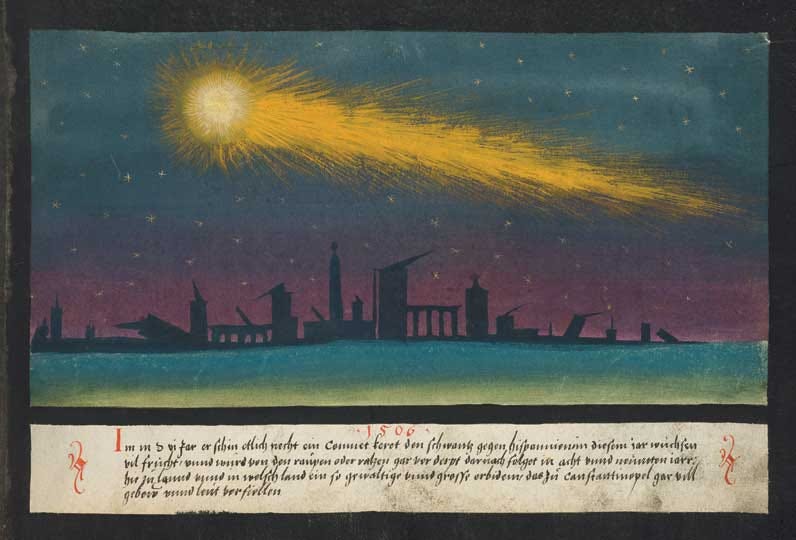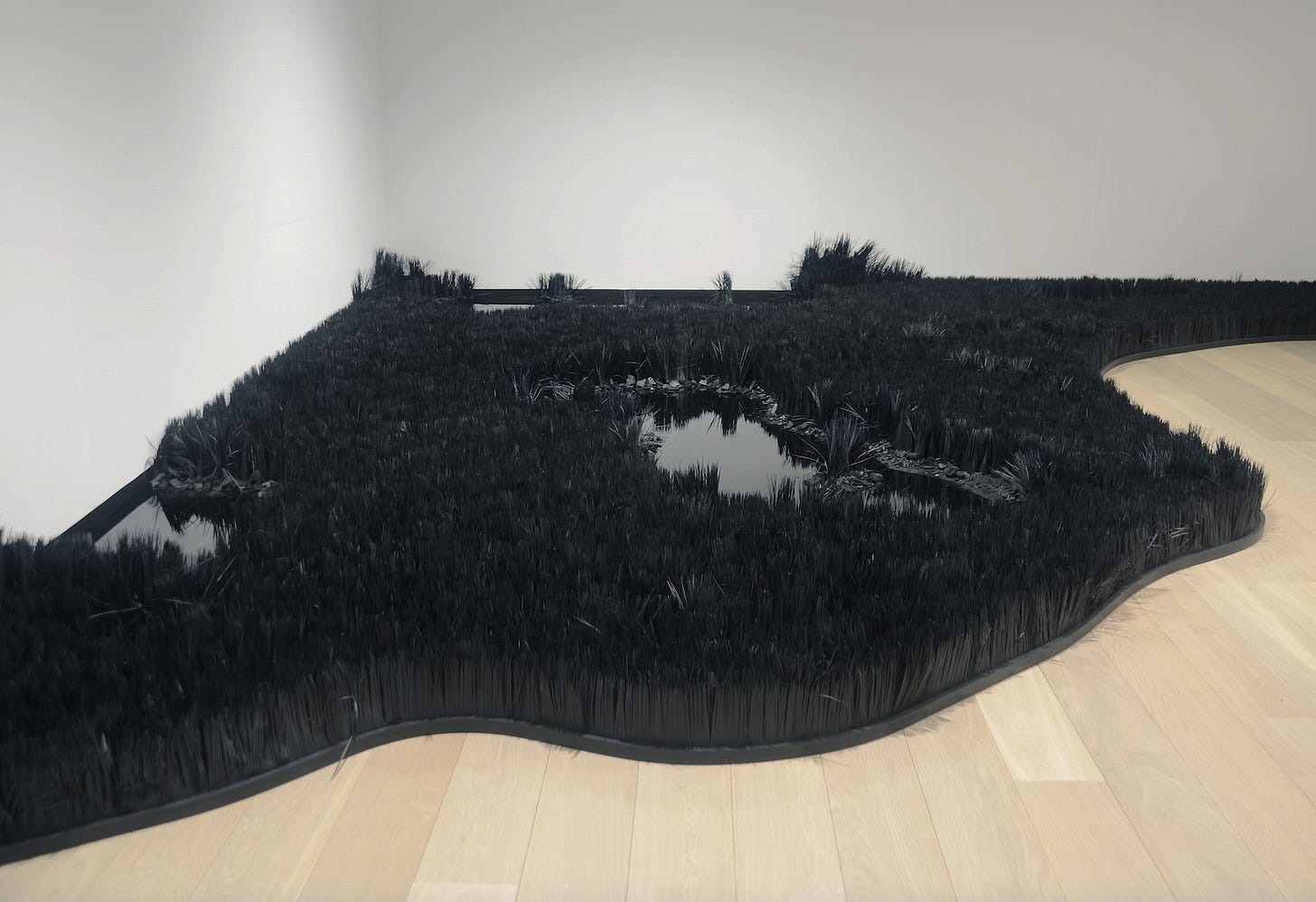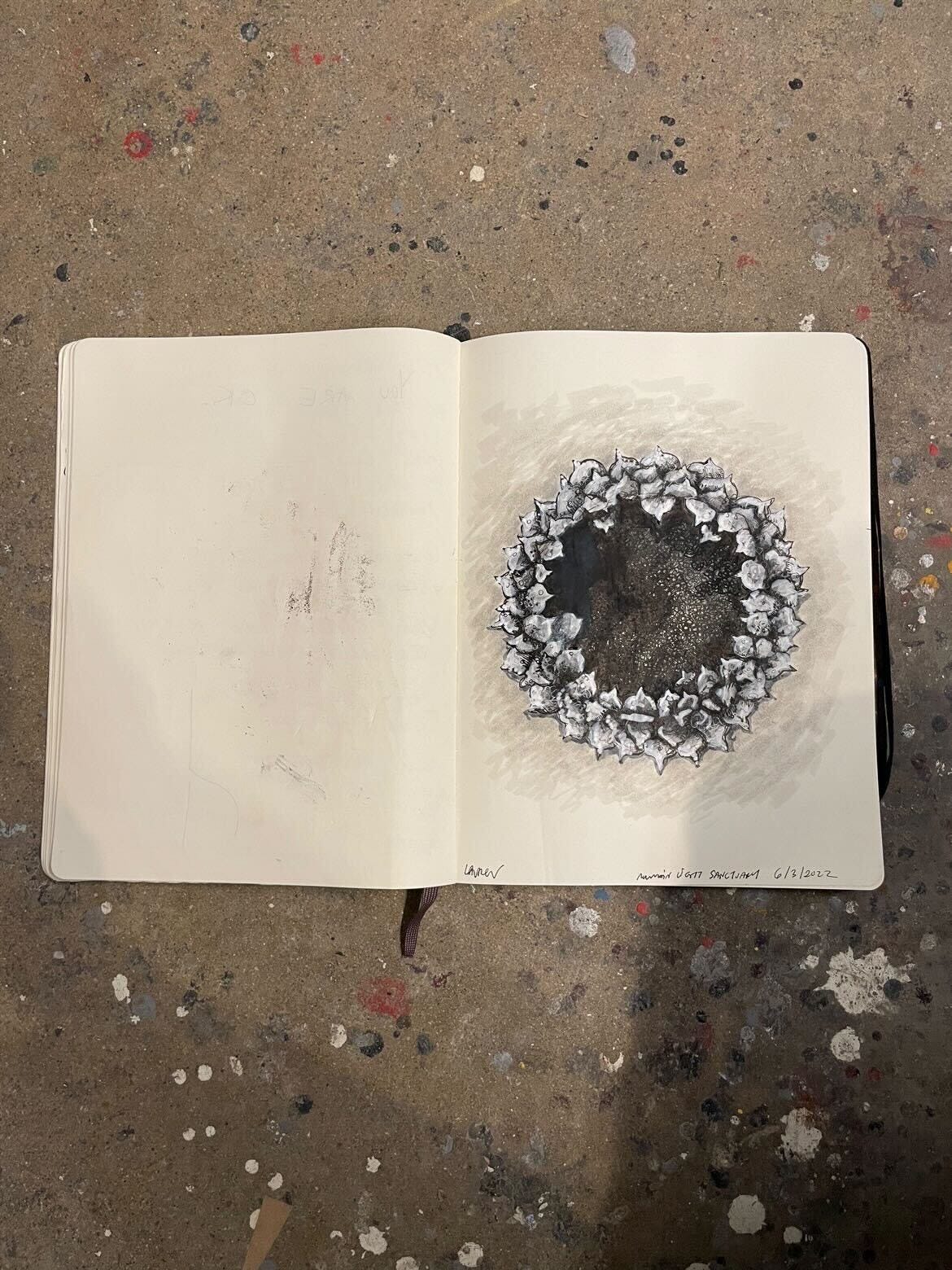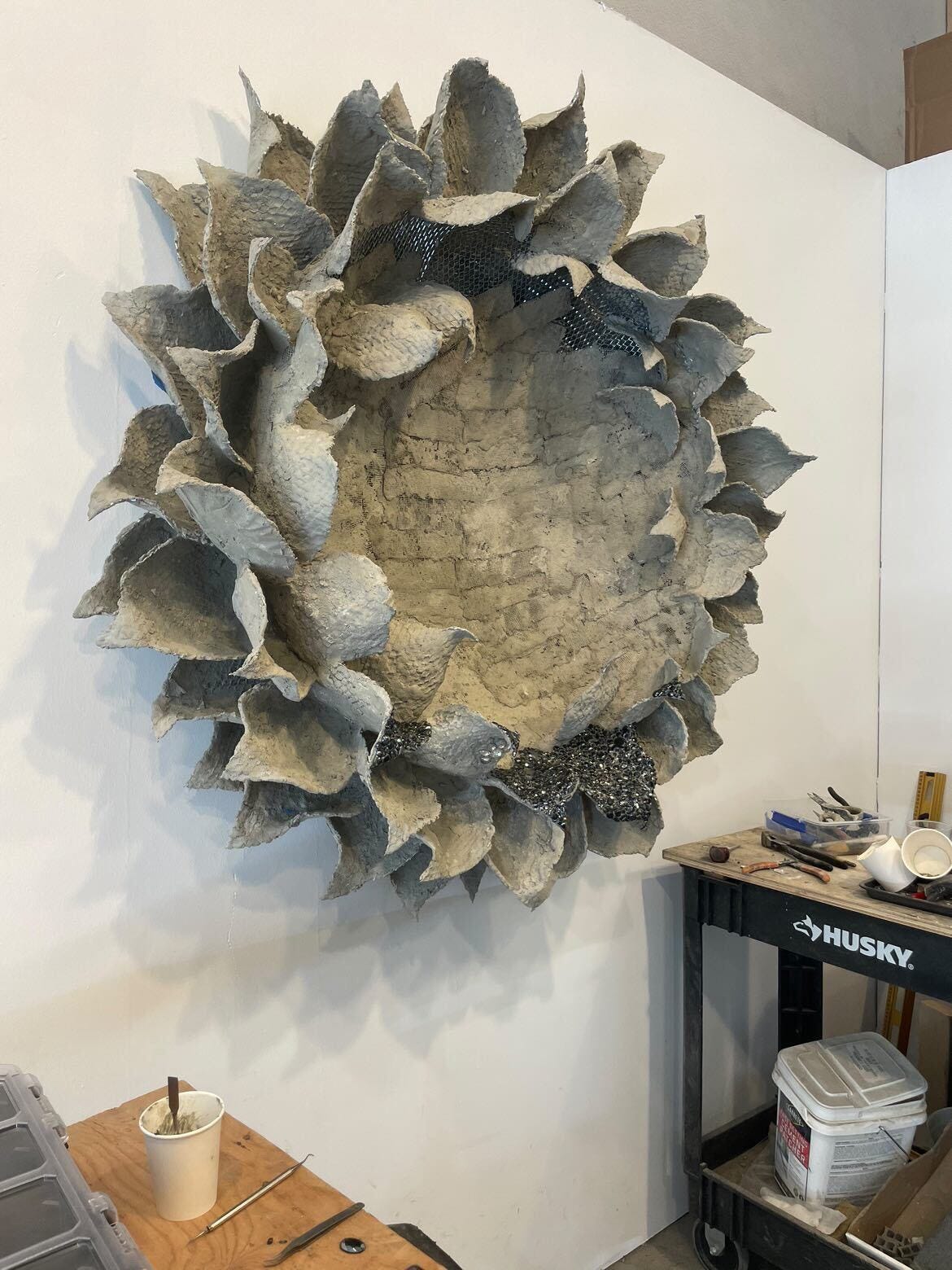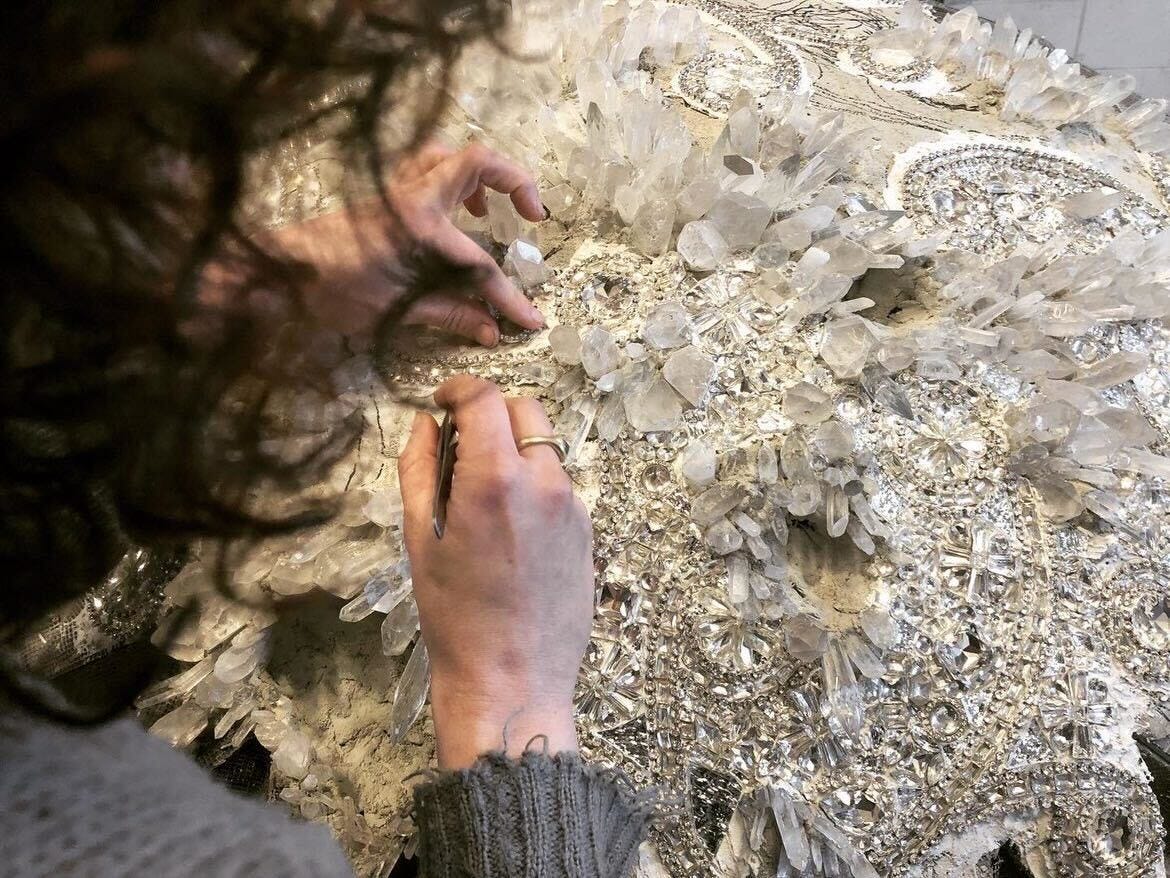Confronting the Glittering Unknown: The Artwork of Lauren Fensterstock
Black holes, imploding suns, and an obsession with philosophy drive the artist's sculptures into a place of sparkling darkness.
The first time I encountered Lauren Fensterstock’s work, my world stopped. I remember thinking: Finally.
The first installation I saw, The Totality of Time Lusters the Dusk, featured a fiery black comet shooting through the pillars of the Smithsonian American Art Gallery.
The comet, flanked by black shimmering clouds, was painstakingly covered in glass, crystals, onyx, and hematite, a shimmering mosaic, shooting over a black reflective pool.

The work was inspired by The Book of Miracles, a sixteenth-century illuminated manuscript cataloging celestial phenomena — including a comet which appeared over the sky of Constantinople at the time of Muhammad’s birth.
Fensterstock’s dedication to research of the sublime, the celestial and the apocalyptic is a hallmark of her work — but by re-casting these subjects in glittering mosaics, they become an earth-side exploration of the otherworldly.
Fensterstock’s training as a metalsmith is so clear in the precision of her work: Each element is so painstakingly hand-crafted that it is impossible to look away from.
Beyond the dedication to the intricacies of her pieces, Fensterstock’s work pulls me in because it feels as if she is in a beautiful discussion about the meaning of life, the end of the world, black holes, and the galaxies which surround us. From elaborate scrying mirrors to lakes and fields of black shards and ribbons, her work is confronting an intricate beauty waiting in the darkness.
Artist Spotlight: Lauren Fensterstock
Lauren Fensterstock is the first artist I’m going to feature in a new Artist Spotlight series. Each artist answers the same six questions however they’d like, offering deeper insight into how they came to art, their philosophy, and their work. I’m so excited to share her answers today.
SRE: Tell us a little bit about how you got to where you are today.How did you begin making art? When did you start making work and what drew you to the practice?
LF: I was a sick kid. When I was 5, I suffered a brain injury that caused me to have violent seizures for most of my childhood. I was constantly blacking out in school and getting shuttled back and forth to neurologists. I was happiest just staying home. Alone in my room I found an exciting world of books and ideas. I read everything I could get my hands on, but in particular I was drawn to esoteric philosophy and fantastical narratives. These were things that felt apart from the embarrassing terror of my everyday life. It was a seductive escape, but I often came across concepts that were hard to grasp. Making things became a vehicle to translate difficult ideas into objects that I could hold in my hand, things I could touch and contemplate intimately. Filling my room with pictures allowed me to create my own reality in my own real space. For a shy lonely kid, this was an absolute lifeline, and a pathway to something greater than my own isolated life.
My studio practice today isn't all that different. I spend most of my time alone in a windowless former car repair garage. The space is full of books, drawings, and sculptures. I spend a huge amount of time reading on my studio sofa. Questions from books bring me to my drawing table where I make sketches and mind-maps. This is the step where I really grapple with my thinking and how it can be represented visually. When something rises up out of that process and feels "right" I bring it to life in three-dimensions. I'm basically still just that weird kid hanging out alone in her room.
SRE: What are your three biggest influences?
LF: Hmmmm I'd have to say: melancholy, opulence, and transcendence.
SRE: What’s the one piece of yours that you love the most?
LF: Right now, I am working on a piece I am really excited to see come into being. I periodically go all in on a totally consuming project that takes a year or more to complete. In those moments, I compare myself to Noah and the Ark: compelled to bring something to life no matter the time commitment, cost, or consequences.
First, I created a drawing of the piece. I knew it would be really hard to make, that it would require unbearable precision and patience, and that there was a large chance it might be a total failure. I fought it. I tried to avoid it and do something else. Then one day, I was meditating and chanting with mudras, and I felt a huge burning in my solar plexus. Afterwards, when I researched the third chakra, I realized the lotus used to represent it looked exactly like my sketch. I knew I had no choice but to proceed. To some requests, you just can't say no.
The piece is a large wall hanging relief sculpture. The form is part lotus and part imploding sun. The lotus is a symbol of transformation often associated with Buddhism, but found globally since ancient times. The imploding sun form is something that has cropped up in my work over the last two years. When stars die they become black holes - mysterious spaces that are no thing but not nothing. For me, the piece manifests my experience of meditation and explores notions of form and formlessness, dark and light, knowing and unknowing.
Materially, it is loosely a mosaic. Making a mosaic is like completing a giant puzzle. Although you are working towards a whole, your attention is focused on the component parts. Each fit feels like a magic trick. I see bringing many disparate things together into one as an act of healing and unity.
SRE: What are the main philosophical questions your work is interrogating?
LF: I’m interested in the way people project human centered narratives onto the things around us. We define what it means to be human by naming and separating ourselves from everything that we see as not human, isolating ourselves from the rest of the natural world. We see the things that are not us as a site for conquest and a mirror into which we look for personal meaning. For many years I was focused on gardens and the ways people have shaped their landscape to define their place in it.
More recently, my eyes have turned toward the skies. I've been looking at weather events and astronomy. Right now, I am obsessed with black holes and imploding suns. It’s so interesting to me that for much of human history, we believed the Earth was the center of the universe. In the modern era, we perceived the sun as the center. Now, we believe that at the center of the universe is a black hole.
The shift from our own familiar planet to a mysterious absence feels tremendous. It is a turn from ourselves to the unknown. This is both an acceptance that at our core is a nothingness, and an acknowledgement that we are intimately entangled with a vast universe of things beyond our capacity to name and control. To pursue nothing is an act of total submission. For some, this might seem hopeless, but for me it suggests a release. Nothing is the ultimate everything.
SRE: Let’s talk about inspirations: What music do you listen to while you are making your work? Are you reading anything inspiring? What other artists are you currently obsessed with? Are you researching anything wild?
LF: I usually listen to music while I am working. I am obsessed with Leonard Cohen, particularly his later albums. "You Want it Darker,” "Ten New Songs,” and "Old Ideas" are constant soundtracks. Led Zeppelin, David Bowie, and KRS-One are other studio favorites. I also listen to a lot of audiobooks, and always have a few physical books going all at once.
For fiction, I love Orhan Pamuk, Julian Barnes, Haruki Murakami, and Ben Lerner. For nonfiction, I have been reading a lot of Buddhist philosophy. Stephen Batchelor's translation and commentary on Nagarjuna’s Verses From the Center was so beautiful that as soon as I got to the last page, I immediately read it a second time. Amitav Ghosh's The Great Derangement is a book that helped me tie many things together: philosophy, entanglement theory, literary theory and environmentalism. That book was tremendous. I also read a lot of poetry. I just finished Ocean Vuong's new volume Time is a Mother. I only allowed myself one poem a day. Now that I have finished it, I feel like there is a hole in my morning. The absence of a poem is a particularly strange place of longing.
SRE: Tell us a little about what’s next for you.
LF: It's been a busy few years as I rushed from deadline to deadline, even amidst the chaos of the pandemic. Now I've pulled way back. I slowed my pace. I'm focused on my spiritual practice and my daily life. I start the day with yoga and meditate daily. My art practice flows alongside this. I'm trying to focus on the work itself and shut out grasping for affirmation or popular success. Rather than work on a large project where I have to deal with engineers, curators, site specifics, etc, I'm taking time to keep things simple and privately focus on my objects and their effect. I’m embracing that kid alone in her room with compassion.




